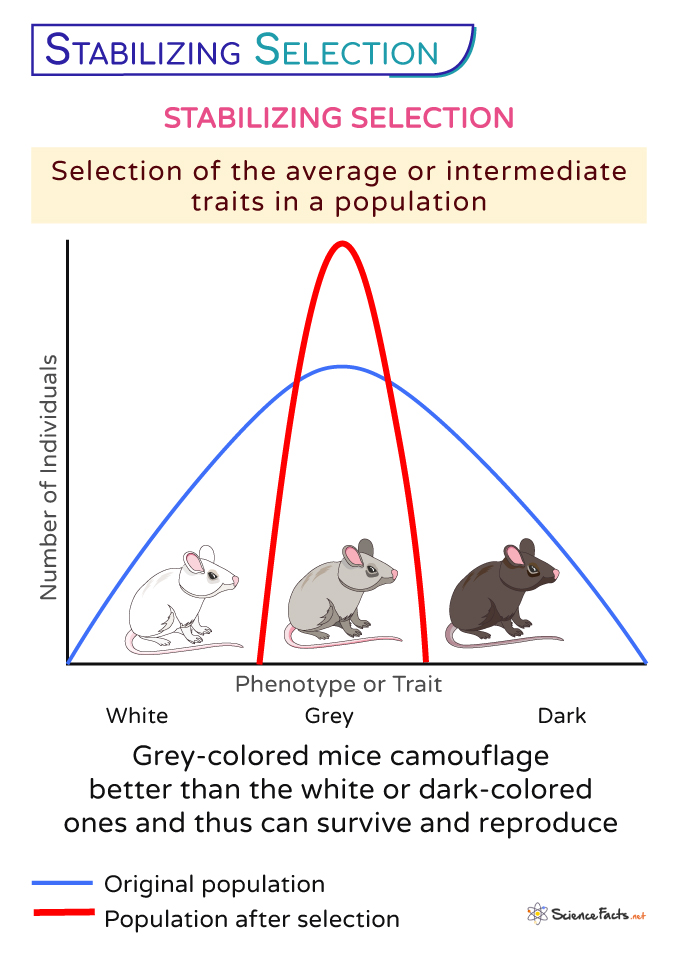Stabilizing Selection
Stabilizing selection, a form of natural selection, favors the intermediate or average traits within a population. In other words, stabilizing selection tends to maintain the status quo, preserving the existing characteristics of a population rather than pushing them toward extremes. It is the opposite of disruptive selection, where the two extreme phenotypes are selected.
Over time, it results in the loss of phenotype as the populations tend to lose extreme phenotypes or attain more moderate phenotypes. Certain species, including humans, have undergone stabilizing selection for so long that modern species are indistinguishable from their ancestors. Stabilizing selection is the most common process of natural selection, as most traits do not change drastically over time.
Evolutionary biologist Ivan Schmalhausen proposed the theory of stabilizing selection in his paper ‘Stabilizing selection and its place among factors of evolution’ in 1941.
Stabilizing Selection Graph
Stabilizing selection is often represented with the help of a modified bell curve, where the central portion is narrower and taller than the standard bell shape, as shown below.
How Does Stabilizing Selection Work
It works when nature selects a moderate phenotype in a population of organisms over the extremes. Such phenotypes attain the best fit with the environment where they can survive and reproduce generation after generation.
Stabilizing selection is favored when selection pressure against phenotypic extremes is essential for decreasing a population’s genetic variance.
Examples of Stabilizing Selection
Human Birth Weight
At birth, infants can vary significantly in weight, from very low to very high. Those with extremely low birth weights struggle to survive due to health complications. In contrast, mothers carrying babies with high birth weights faced difficulties during childbirth. In contrast, babies with an average birth weight, neither too low nor too high, have a higher chance of survival. Over generations, such babies, on becoming adults, are likely to pass on their genetic information to the next generation, thus maintaining the overall birth weight of the population.
Coat Coloration in Animals
Coat coloration in animals, such as deer, rabbits, mice, or squirrels, is also subject to stabilizing selection. It helps them in protection from predators. Such animals have coat colors that are more similar to their environment, which is often an average of too dark and too light.
Plant Height
Tall plants may have better access to sunlight but could be more susceptible to wind damage. In contrast, short plants might have fewer sunlight opportunities but are less prone to wind damage. Plants with intermediate heights strike a balance between the two extremes.
Cactus Spine Density
Cacti with fewer spines are more susceptible to herbivores. At the same time, those with too many spines are found to obstruct sunlight and thus reduce photosynthesis in them. Thus, Intermediate spine cacti are favored by nature to keep a balance on both population and the efficiency of energy assimilation.
Clutch Size in Robin Nest
Like many bird species, Robins face a trade-off regarding clutch size – the number of eggs they lay in a nest. A small clutch size may need more offspring to ensure the species’ survival. In contrast, an oversized clutch size can stretch parental resources thin and reduce survival rates for individual chicks. Stabilizing selection favors an intermediate clutch size of 4 that optimizes the balance between the number of offspring produced and the care they can receive from the parents.
Contrast Stabilizing and Disruptive Selections
Stabilizing and disruptive selections are the exact opposite of each other.
While stabilizing selection prefers moderate phenotypes in a population, disruptive selection selects the extremes. Also, the rate of variation in population is different in both.
However, despite such differences, both stabilizing and disruptive selections cause variations in phenotypes in a population, which is common to both.
-
References
Article was last reviewed on Tuesday, December 19, 2023




